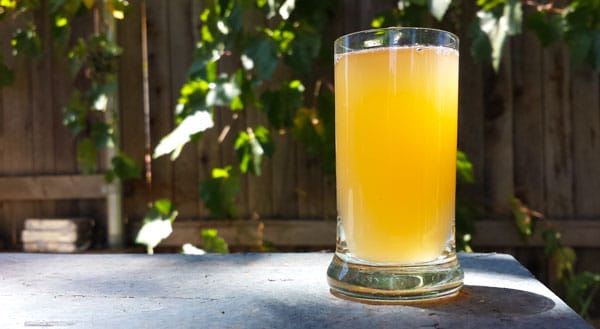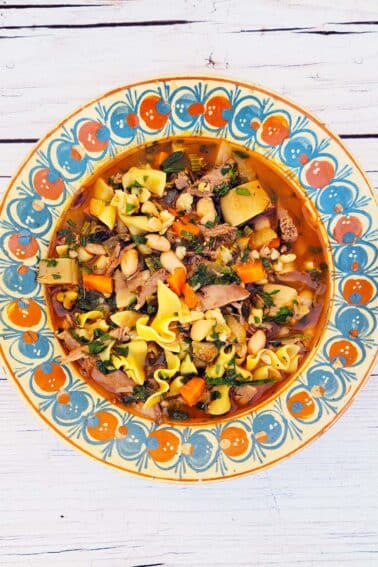As an Amazon Associate I earn from qualifying purchases.

You know the old saying, “When life gives you lemons, make lemonade?” Well, when life gives you unripe grapes, make verjus.
Sometimes I am not around in autumn to harvest the grapes in my yard. Sometimes I want a finer crop for wine, so I thin the fruit from my little vineyard of 11 plants.
Lest you think I could just gorge myself on grapes if I didn’t want to make wine, keep in mind that wine grapes are small, with lots of seeds — so they’re not the best for eating off the vine. What’s more, I hate the idea of wasting, so I make verjus.
Verjus, pronounced vehr-ZHOO, is a sort of vinegar made from the juice of unripe grapes. (It can also be spelled “verjuice”) The grapes you see in the picture are not green grapes, they are Zinfandel grapes, which will turn a lovely burgundy in a month or so. You can make verjus with any unripe grapes, even wild ones. You want to pick them the moment a few start to turn color.

As you may have surmised by the name, verjus is a French creation.
Traditionally it is made with the thinnings of a vineyard’s crop — the French thin their crop dramatically for reasons having to do with both the quality of the wine and because grapes can struggle to ripen in their comparatively cold climate. Many good California vineyards drop fruit in July to make the vines focus their energy on the remaining clusters. This makes better wine down the road.
Verjus itself is really nothing more than sour, acidic grape juice. But what it does is give a recipe acidity without the hammer of a true vinegar. A dish acidified with verjus will remain wine-friendly — if you’ve ever eaten vinegar pickles while drinking wine you will know that this is not a good combination…
So how do you make verjus? You will need unripe grapes. Lots of them. Anything you do with grapes requires many pounds for what seems like a small amount of juice. In winemaking, the ratio is typically 12 pounds of grapes to 1 gallon of wine. My verjus ratio was more like 12 pounds of grapes for about 2 to 3 quarts of verjus. So yeah, you need a bucket of grapes to make this.
Fortunately, green grapes grow near you. Most every place in America has wild grapes, usually along riversides. Go find some and fill a five-gallon bucket full. Or thin your personal vineyard…
How to Make Verjus
Ingredients
- 10 pounds unripe grapes
- 1 teaspoon citric acid
- 1/2 teaspoon sodium metabisulfite
Instructions
- Take most of the stems off the grapes. This will take some time, maybe an hour or so. Longer if you've never done it before. But if you don't do this part, you will have a tough time running the grapes through the food mill.
- Grind the grapes through a coarse die on your meat grinder. Sadly, the Kitchenaid attachment isn't strong enough for this task, so you need a real grinder. I use a 7 mm die -- large enough to let the seeds get through (you don't want to crush them) and small enough to grind even small grapes. If you have the meat grinder, this process takes only a couple minutes. If you don't, you can use a food mill fitted with a coarse plate. This is a distant second and will require a little elbow grease.
- As you get a slurry of ground-up grapes and grape juice, pour it into a bowl as you work. You will need to work quickly, as the grape juice will oxidize and turn brown. There is really no getting over this, but the faster you work the greener -- or at least more golden -- your verjus will be. Work slow and it will look like malt vinegar.
- Now you need to run the ground grapes through a fine mesh sieve. If you have rubber gloves, put them on. Why? The acid in these grapes made my hands sting for a couple hours after I squeezed the ground-up grapes over the sieve. And yes, you need to squeeze your grapes because you really want as much liquid as you can extract.
- You can take an optional step of straining the juice a second time through the strainer with a paper towel set inside. This will remove a lot of the extremely fine particulate matter floating in your verjus. As you pour, it will catch in the paper towel, eventually stopping the flow of the verjus. You will need to replace the paper towels a couple times.
- Finally, you will need to pour the strained juice into a Mason jar. It's at this point that you add the citric acid and sodium metabisulfite, if you are using them. Shake the jar well to mix everything in, then put it in the refrigerator for up to 2 days. There will be a very fine layer of sediment on the bottom, even if you did the paper towel trick. You will not be able to strain this off -- it is too fine.
- So, what you need to do is gently decant it into a clean container. You will lose some verjus, but that's OK. If you don't do this step your verjus will oxidize even more. Nothing bad will happen, but it will look ugly.
- Bottle and store in the fridge. It should last for several months in the refrigerator, and up to 9 months if you use the citric acid and sodium metabisulfite. You can also freeze it.
Notes
Nutrition information is automatically calculated, so should only be used as an approximation.

Braised Pheasant with Mushrooms
This is one of my favorite things to make with verjus. Great with chicken thighs, too.
Read More




I just made a gallon of verjus by hand mashing the grapes in a large container with a potato masher that had teeth and then pressing the grapes with a berry press (it’s like a small table-top version of an apple cider press). This way eliminated the need to strain the juice, since the press uses a bag to contain the pressings (just like an apple press does). Works well. Everything needs to be set up before putting the mash into the press because some of the juice will immediately flow through the bag as you are pouring the mashings into the bag in the press. One year I tried the KitchenAid mixer juicer attachment, it was a disaster. Verjus is meant to be handmade not machine made.
My mother used to make verjuice by straining it and then adding a ton of salt, bottling it in old juice bottles and leaving it in the garage. We only ever used it for salads so when we added it to a salad with olive oil, we wouldn’t add any salt since it was salty already. I am wondering if I use your method of citric acid and sulfite can I skip the salt and more importantly, can I leave it outside of the fridge? I wont have room in my fridge for a years supply of the stuff once made.
Hi there! I want to make this recipe but wanted to know if you can can this in a water bath or pressure canner to preserve at a shelf stable environment?
Do you have any suggestions?
Caroline: I’ve not tried either method. I keep it in the fridge, where it will be stable for many months.
Hi, can you put the grapes in a juicer instead?
Thanks
Sam
Samantha: Probably? I’ve never tried because I don’t have a juicer.
I’ve made verjus for several years , never added the stabilizers and had it for long time refrigerated— I make it by hand in my molcajete!!
I strain etc but I love some of that residu to remain for richness
This year ( tomorrow) I’m using interlaken and Roger’s red grapes because it’s what I bagged and rescued from either raccoons or rats!! Small organic container farm next to my 1968 airstream international
Why should you not crush the seeds? And is it a problem if yo do?
Chris: The seeds are bitter.
Here in South Africa the monkeys usually get the grapes and make a huge mess on the verandah. This way I get to have some! Thanks v much!
Raccoons destroy my grapes when they start ripening. I gave up fighting with them and now make verjus. I tried a food mill once but now use a steam extractor. It makes it way way easier.
Cheers!
Can this be canned? Hot water bath or pressure canned? Any idea what would happen if I used my steam juicer?
Kari: It shouldn’t need it. Normally the PH of verjus is between 2 and 3, which is basically vinegar, and that is shelf stable.
I used my Cuisinart with the small plastic blade – it did not cut the seeds but it mashed the grapes up very well (Chardonnay grapes, small and seedy!). Just pulsed a few times until very soupy then sieved. Really nice sour flavor, but not sharp. Made salad dressing with olive oil – excellent. Also mixed with soda water over ice. Lovely. Looking forward to a trying a braise… Thanks, Hank.